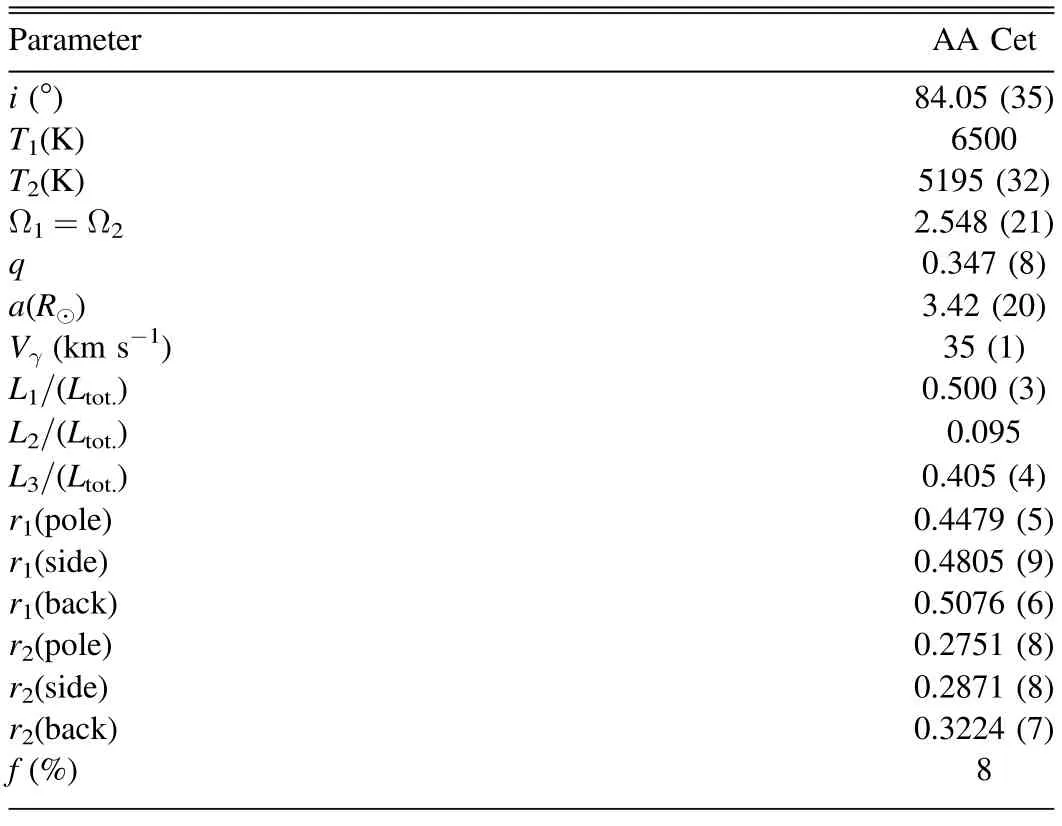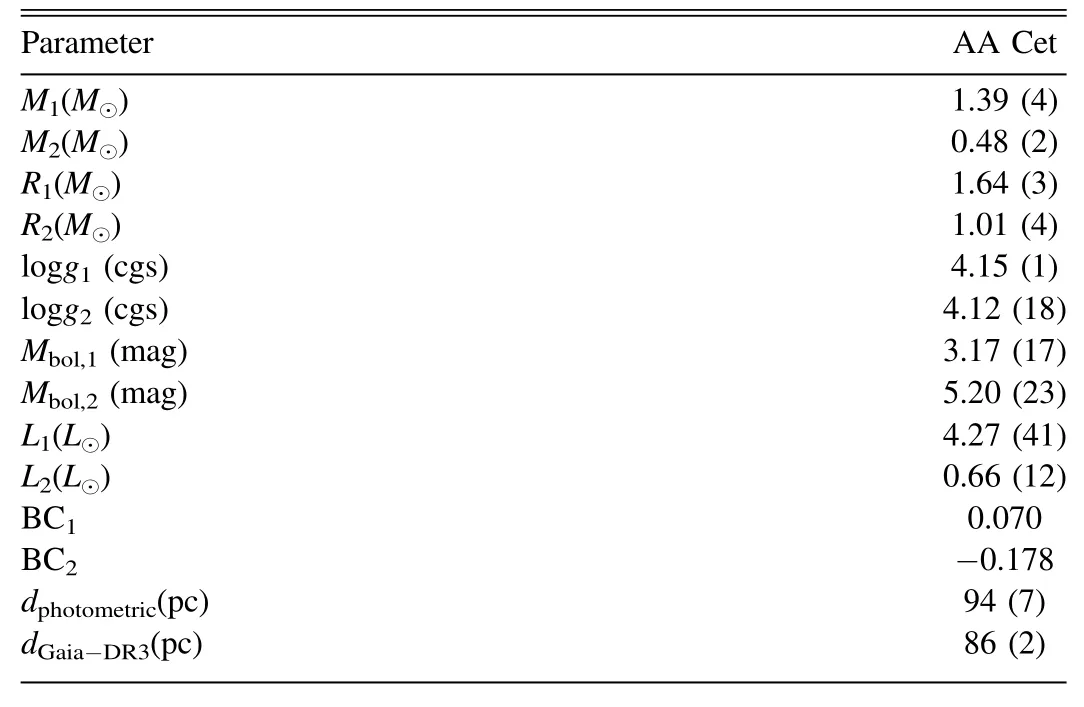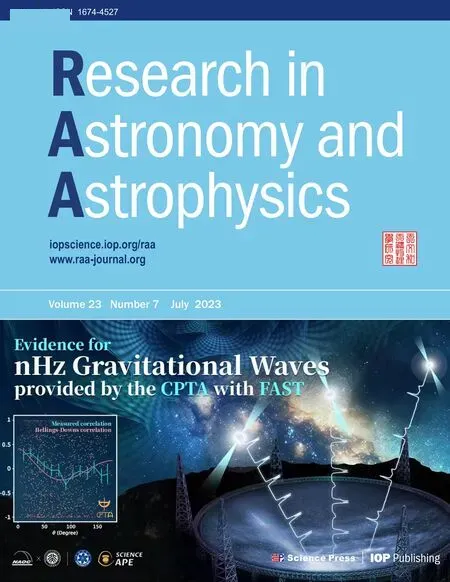First Detailed Photometric Investigation on the Nature of Contact Binary System AA Cet
M.F.Yıldırım and F.Soydugan,2
1 Çanakkale Onsekiz Mart University,Astrophysics Research Center and Ulupınar Observatory,17020,Çanakkale,Turkey;mf.yildirim@hotmail.com
2 Çanakkale Onsekiz Mart University,Faculty of Sciences,Department of Physics,17020,Çanakkale,Turkey
Abstract The TESS light curve (LC) of the marginal contact binary AA Cet was analyzed simultaneously with the radial velocity and the orbital period(OP)change of the system was investigated.The physical parameters of the system were obtained by analyzing the LC of AA Cet with the Wilson-Devinney method,and the absolute parameters of the components were calculated using the results obtained.For the components of AA Cet,the masses and radii were calculated as M1=1.39±0.04 M⊙, M2=0.48±0.02 M⊙and R1=1.64±0.03 R⊙, R2=1.01±0.04 R⊙,respectively.AA Cet is a marginal contact binary with a temperature difference of 1305 K between its components.A total of 14 eclipse times were obtained from the TESS data and used in the OP analysis together with those collected from the literature.It has been observed that the change in the OP of AA Cet is in the form of a decreasing parabola.Conservative mass transfer between the components has been interpreted as the reason for this change.The OP decrease amount of AA Cet was obtained as dP/dt=0.0062±0.0006 s yr−1,and the reason for this decrease was attributed to a 3.3(9)×10−8 M⊙mass transfer per year from the more massive component to the less massive one.The age of AA Cet has been estimated as 7 Gyr,as the age of contact systems helps us to understand their evolution.
Key words: (stars:) binaries: eclipsing–stars: fundamental parameters–stars: individual (AA Cet)
1.Introduction
Because contact binaries (CBs) are encircled by a common envelope,the surface temperatures of the components are almost the same.However,for some CB systems (e.g.,AA Cet),the temperature difference between the components is quite large.Many authors (e.g.,Flannery 1976;Lucy 1976;Qian 2001a,2001b,2003) have attempted to explain this situation with thermal relaxation oscillation(TRO).Binnendijk(1970) categorized CBs into A and W-type subclasses.For eclipsing binaries (EBs),the most easily determined parameter is the orbital period(OP).A subclass of EBs,the CBs,usually have OPs of less than one day.A statistical study on 700 CBs was conducted by Latkovic et al.(2021).They reported that the OPs of such systems were mostly shorter than 0.5 day.A correlation between the OP and the masses of the components was determined by Gazeas &Stepien (2008) using 112 CBs.The relationship betweenM−RandM−Lfor the CBs was obtained by Zhang et al.(2020).The reason why the second components of the A and W types are overluminous is due to the fact that the second components for A types have evolved from more massive stars,while the W types are due to energy transfer (Zhang et al.2020).Thanks to these correlations obtained from such studies in the literature,general inferences can be drawn about CBs.By determining the basic astrophysical parameters of binary stars,information about the evolution of the systems can be obtained.Therefore,the marginal contact AA Cet,whose basic astrophysical parameters are unknown,was chosen,and its basic astrophysical parameters were calculated.
The difference between eclipses of the marginal CB AA Cet(HD 12180,ADS 1581 A,TIC 266769522,Gaia DR3 5134682575449602560,SAO 167451,TYC 6430−631−1) is quite large,and the OP of AA Cet is about half a day.AA Cet was discovered by Bloomer (1971a) as a variable system,and light elements were reported by Bloomer (1971b).The light elements for AA Cet were updated by Bloomer (1972) asTo=2441268.6869(7) andP=0.53617353(50),and calculated differently from Bloomer (1971b).The study of a new quadruple star system was done by Chambliss (1981).In the same study,it was reported that the visual binary was composed of an AA Cet member with SAO 167451 and another member with SAO 167450.SAO 167450:It was stated by Chambliss (1981) that it is a double-lined spectroscopic binary,but eclipses are not observed.(Radial velocity (RV)values are calculated as −12(2) km s−1and +68(1) km s−1.)The spectral type of AA Cet(SAO 167451)was determined as F2 and the spectral type of SAO 167450 as F5 by Chambliss(1981).The RV curve analysis of AA Cet was made by Duerbeck &Rucinski (2007),and they determined the mass ratio of AA Cet to beq=0.35(2).In addition,the RV study of the system was also done by Pribulla et al.(2009),and the spectral type of AA Cet was determined as F4V.A study of the other member of the visual binary,SAO 167450,was performed by Fekel &Willmarth (2009).They also reported that the system is quadruple.There is no photometric analysis study on AA Cet in the literature.For this reason,AA Cet was selected in this study,and photometric analysis was performed for the first time.
2.Data Information
Photometric observations of the visual binary AA Cet were made by the TESS satellite (Ricker et al.2015).Photometric observation data were archived by MAST.3MAST,https://archive.stsci.edu.TESS observations for AA Cet were made for about a month in 2018 (starting on the 20th of September and completed on the 17th of October).In addition,a one-month observation was made in 2020,which started on September 23 and was completed on October 20.While the exposure time of the 2018 observation was 120 s,the exposure time of the 2020 observation was 600 s (sequence numbers: 3 and 30,respectively).The light curves (LCs) of TESS data are in Barycentric Julian Date(BJD),but data in the literature are usually in Heliocentric Julian Date (HJD),so the data were transformed from BJD into HJD.The eclipse times were calculated from the LC data using a code based on the least squares method.Eclipse times for OP analysis were taken from theO−Cgateway (Paschke &Brat 2006) and listed in Table 1 along with those calculated from the TESS data.

Table 1The Eclipse Times used in the Orbital Period Analysis for AA Cet (The O −C values were Calculated using Equation (4))
3.The Light Curve Modeling
Since the LC analysis of AA Cet has not been done yet,it is aimed to model the sensitive TESS LC data of the system.For analysis,the van Hamme &Wilson (2003) version of the Wilson-Devinney (WD,Wilson &Devinney 1971) code was preferred.While performing the LC analysis,the analysis was first conducted in Mode 2 for detached binaries.During the analysis,it was observed that both components filled their Roche lobes.After that,Mode 3 was chosen for the CBs,where both components filled their Roche lobes.The spectral type of AA Cet was determined as F4V by Pribulla et al.(2009),and the temperature of the first component was taken as 6500 K,as recommended by Eker et al.(2020) according to this spectral type.The gravitational darkening coefficients and the bolometric albedo coefficients were taken asg1=g2=0.32 (Lucy 1967)andA1=A2=0.5 (Rucinski 1969),respectively,with the assumption of a convective atmosphere.The logarithmic edgedarkening coefficients given by van Hamme (1993) were used.In the LC analysis for AA Cet,the analysis was started with the initial mass ratio value reported by Duerbeck &Rucinski(2007).The LC of AA Cet was analyzed simultaneously with the RV data obtained by Duerbeck &Rucinski (2007) and archived in the SB9 database4SB9 database,http://sb9.astro.ulb.ac.be.by Pourbaix et al.(2004).Correction amounts and errors were calculated for the free parameters using the differential correction (DC) method in the WD program.(The free parameters in the analysis,along with their errors,are listed in Table 2.)In iterations,if the correction amounts of the free parameters are smaller than the errors,the solution is reached.The parameters derived from the LC analysis are listed in Table 2,and the compatibility between the observational data and the theoretical fit in the LC graph is illustrated in Figure 1.A comparison of the observational RV data with the theoretical fit obtained from the analysis is also depicted in Figure 2.

Figure 1.The best theoretical fit for AA Cet’s TESS LC.

Figure 2.Comparison of RV data for components of AA Cet with theoretical curves.

Table 2Parameters and Their Errors found from Simultaneous Analysis of Light and RV Curves of AA Cet
4.The Orbital Period Variation
It is very important to examine the OP changes of binary systems in terms of providing information about their structures and evolutions.OP changes can be in the form of an increase or decrease in the period.Mass and angular momentum transfers change the OP of AA Cet.To determine the OP change,theO−Cgraph is created by taking the difference between the observed (O) and calculated (C) eclipse times.If there is a change in the OP of the system,it will be observed in theO−Cgraph as a form of an up or down parabolic change.O−Cgateway (Paschke &Brat 2006) and AtlasO−C(Kreiner 2004)databases were used first,since the OP analysis of AA Cet has not been performed so far.It was seen from both data archives that the OP of AA Cet decreased;the light elements of AA Cet are expressed in Equations (1) and (2) for theO−Cgateway and AtlasO−C,respectively.
In these equations,Erepresents the number of cycles.In theO−Canalysis,these light elements were chosen as initial values.As a result of the analysis,light elements and errors in Equation (3) were obtained.
Since AA Cet is a CB,mass transfer between components may cause anO−Cvariation.If the mass transfer is large enough,a parabolicO−Cchange will be observed.The OP change analysis was performed with a total of 264 eclipse times(14 eclipse times calculated from TESS data in this study),and it was seen that the OP of AA Cet decreased with time (see Figure 3).A differential correction method was applied to obtain the light elements and quadratic term in Equation (4)using the eclipse times in Table 1.

Figure 3. O −C graph of AA Cet and the best theoretical parabolic fit representing the O −C variations.
The parameters and errors derived from theO−Canalysis are presented in Table 3,and theO−Cgraph is displayed in Figure 3.Looking at the data distribution of about 60 yr,it is seen that the OP of AA Cet shows a constantly decreasing change (see Figure 3).The OP decrease of AA Cet has been calculated at 0.62±0.06 s per century,and the reason for this can be suggested as conservative mass transfer between components.

Table 3The Parameters and Errors Derived from the O −C Analysis of AA Cet
5.Results and Discussion
There is no LC analysis related to the AA Cet system in the literature.The LC obtained from TESS data for AA Cet was analyzed by the WD method,and the physical parameters of the system were obtained.In the analysis,photometric data were combined with the RV data obtained by Duerbeck &Rucinski(2007).The absolute parameters of the components of AA Cet were calculated by basic astrophysical equations using parameters obtained from simultaneous analyses of light and RV curves (see Table 4).The temperature difference between the components was calculated as 1305 K,and the system may not have reached thermal equilibrium.The degree of contact of AA Cet was calculated to bef=8%,and it was seen that it has a marginal contact of type A.The mass ratio of AA Cet was obtained asq=0.347±0.008,which supports the value ofq=0.35±0.02 calculated by Duerbeck &Rucinski (2007).While calculating the absolute parameters for AA Cet,the values for the Sun determined by Pecaut &Mamajek (2013)were used (Teff⊙=5771.8(7) K,Mbol⊙=4.7554(4) mag,g⊙=27423.2(7.9) cm s−2).Bolometric correction (BC) values for the components were reported by Eker et al.(2020)and are given in Table 4.For AA Cet,the masses and radii of the components were calculated asM1=1.39±0.04M⊙,M2=0.48±0.02M⊙andR1=1.64±0.03R⊙,R2=1.01±0.04R⊙,respectively.The photometric distance of the system was calculated as 94±+6 pc,and this value is consistent with the value from Gaia Data Release 3 (DR3,Gaia Collaboration 2022)(see Table 4).Since the AA Cet system is a member of a visual binary,the third light contribution value was determined to be approximately 41%.The ratio of apparent luminosities determined from the broadening functions are estimated asl3/(l1+l2)=0.59 by Pribulla &Rucinski (2006).The value we obtained(approximately 0.68)was slightly larger than their estimated value.

Table 4Basic Physical Parameters and Errors of AA Cet
An OP analysis of AA Cet with 264 eclipse times(ccd=32,pe=1,pg=21,vis=196 and TESS=14) spanning approximately 60 yr was performed for the first time.It has been observed that the OP of AA Cet has decreased,and especially the eclipse times calculated in this study support this decrease.For AA Cet,the OP decrease rate was calculated asdP/dt=7.2(7)×10−8d yr−1.The reason for this decrease has been suggested as mass (and energy) transfer between components with the assumption of conservative mass.This rate was calculated asdM/dt=3.3(9)×10−8M⊙yr−1from the more massive component to the less massive one.The decrease in OPs of eclipsing systems may be due to either conservative mass transfer between components or angular momentum loss(AML)of the systems.There is no evidence of magnetic activity for AA Cet both in this study and in the literature.Many authors have stated that the reason for the decrease in OPs of CBs may be due to TRO or TRO+AML(e.g.,Qian 2001a,2001b,2003;Yıldırım 2023).Therefore,the OP variation of AA Cet can also be explained by TRO.As a result of the LC analysis,the value of third light contribution(l3) was obtained to be approximately 41%,but no sinusoidal change was observed in the OP analysis.AA Cet and SAO 167450 are members of the visual binary system.Both members of this visual binary are also binary systems and the system is quadruple in total(Fekel&Willmarth 2009).The light contribution of SAO 167450 was determined asl3in LC analysis because this visual member is located only 8″ from AA Cet(Table 2).The magnitude difference inVfilter between AA Cet and its visual companion SAO 167450 is only 0.33 mag (Perryman et al.1997).Considering this value,thel3/l1ratio(light ratio between the primary component of AA Cet and SAO 167450) inVfilter can be estimated to over 0.80,which agrees with thel3/l1value found in the TESS LC solution(Table 2).On the other hand,a sinusoidal change would be very difficult to observe in the OP analysis because the OP of the visual binary is very long (Fekel &Willmarth 2009).
Since the systems with a low degree of contact are not in thermal equilibrium,the temperature difference between the components becomes larger than normal.The AA Cet system is most likely not in thermal equilibrium,and several systems similar to AA Cet have been selected from the literature and are listed in Table 5.In terms of OPs and degrees of contact,the selected systems show similar characteristics to AA Cet.Depending on the absolute parameters calculated for AA Cet,the locations of the components in the Hertzsprung–Russell(HR)diagram are shown in Figure 4.According to the Padova evolution model (Bressan et al.2012),the logTeff−logLgraph for the systems in AA Cet and Table 5 is displayed in Figure 4 (forZ=0.014).In this diagram,the positions of the systems in Table 5 are also plotted to compare the position of AA Cet.According to the HR diagram,the second components seem to have evolved and left the main sequence,while the primary components are located on the main sequence.The secondary component of AA Cet is located closer to the Terminal Age Main Sequence (TAMS),unlike the secondary components of other systems.

Figure 4.Positions of the components of AA Cet(red),SZ Hor(black),TT Cet(royal blue) and BX And (violet) in log Teff–log L diagram.Evolutionary tracks,and Zero Age Main Sequence (ZAMS) and TAMS lines are drawn according to the Padova evolution model (Bressan et al.2012).The solid hexagons in the diagrams are their primary components;the hollow hexagons represent their secondary components.

Table 5Some Information about a Few Marginal CBs Selected from the Literature
A method based on the initial masses of the systems has been proposed by Yıldız (2014) to calculate the ages of CBs.The kinematic ages calculated for the CBs and the age calculation based on the initial masses are quite compatible with each other(Bilir et al.2005;Yıldız 2014).The mean ages of A and W subtypes of CBs were calculated by Yıldız (2014) as 4.4 and 4.6 Gyr,respectively.The kinematic age of the CBs was determined as 5.47 Gyr by Bilir et al.(2005).The age of the marginal CB AA Cet was estimated to be 7 Gyr using the method proposed by Yıldız (2014) and used by Latkovic et al.(2021).
As a result,LC and OP analyses of the marginal CB AA Cet were performed in this paper.The basic physical parameters of AA Cet and the results of OP variation were presented for the first time to the literature.In this respect,this study will contribute to the literature in terms of both data and results.In future studies,precise spectral and photometric observation analyses will make significant contributions to our understanding of the nature and evolution of the system.In particular,studies on the other member of the visual binary will be very important in understanding the nature of this system.
Acknowledgments
We thank the referee for his/her suggestions and contributions.This work has made use of data from the European Space Agency (ESA) mission Gaia (https://www.cosmos.esa.int/gaia),processed by the Gaia Data Processing and Analysis Consortium (DPAC,https://www.cosmos.esa.int/web/gaia/dpac/consortium).Funding for the DPAC has been provided by national institutions,in particular the institutions participating in the Gaia Multilateral Agreement.This research has made use of the SIMBAD database,operated at CDS,Strasbourg,France.This paper includes data collected by the TESS mission.Funding for the TESS mission is provided by the NASA Science Mission Directorate.The MAST,AtlasO−CandO−Cgateway databases were used in this paper.Thus,we express our gratitude to the working groups of MAST,AtlasO−CandO−Cgateway.
 Research in Astronomy and Astrophysics2023年7期
Research in Astronomy and Astrophysics2023年7期
- Research in Astronomy and Astrophysics的其它文章
- In Search for Infall Gas in Molecular Clouds: A Catalogue of CO Blue-Profiles
- Pulsation Analysis of High-Amplitude δ Scuti Stars with TESS
- Cross-correlation Forecast of CSST Spectroscopic Galaxy and MeerKAT Neutral Hydrogen Intensity Mapping Surveys
- Mock X-Ray Observations of Hot Gas with L-Galaxies Semi-analytic Models of Galaxy Formation
- NuSTAR View of the R-Γ Correlation in the Hard State of Black Hole Lowmass X-Ray Binaries
- Fermi Blazars in the Zwicky Transient Facility Survey: A Correlation Study
